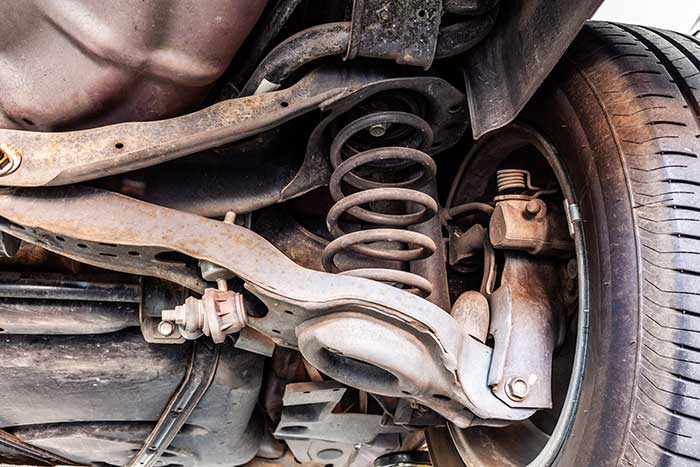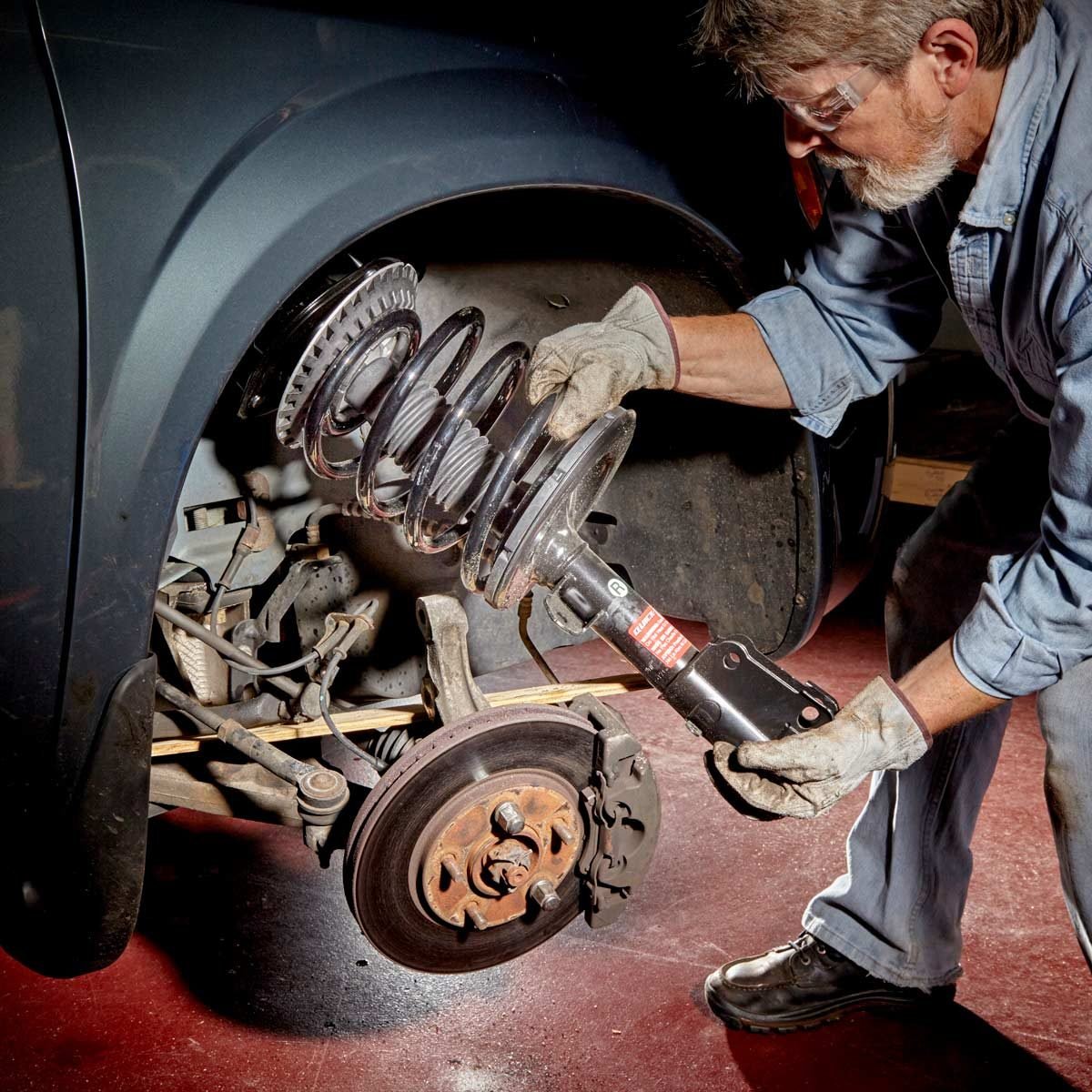Have you ever felt your car bouncing more than usual or noticed a dip in handling performance? If so, it might be time to replace your shocks and struts.
But how long does this process actually take? You might be imagining a long day at the repair shop, but the reality could surprise you. Understanding the time investment required can help you plan better and keep your vehicle running smoothly.
You’ll discover exactly what goes into replacing shocks and struts, how it affects your car’s performance, and what you can expect in terms of time commitment. Uncover the secrets to a smoother ride and save yourself from unnecessary delays by diving into the details below.

Credit: www.autoscopecarcare.com
Signs Of Worn Shocks And Struts
Recognizing the signs of worn shocks and struts can save your vehicle. Worn shocks and struts may affect your car’s performance and safety. Ignoring these signs could lead to more costly repairs.
Signs Of Wear On Bumpy Roads
Does your car bounce excessively on bumpy roads? This might indicate worn shocks. The vehicle should absorb road imperfections smoothly. If not, it may be time for a replacement.
Unusual Tire Wear Patterns
Check your tires for uneven wear. This can signal a problem with your shocks or struts. Uneven tire wear means your vehicle isn’t distributing weight evenly.
Nose Dives During Braking
Does the front of your car dip when braking? This behavior is called “nose diving.” It’s a common sign of worn shocks and struts, affecting stopping distance.
Excessive Body Roll In Turns
Feeling excessive swaying or rolling in turns? This can indicate worn struts. Your car should remain stable and controlled in turns.
Fluid Leaks On Shocks
Inspect your shocks for fluid leaks. Leaking fluid is a clear sign they are worn out. Shock absorbers rely on fluid to function properly.
Strange Noises Over Bumps
Hearing clunking noises over bumps? This might suggest worn or damaged shocks. Noises often mean parts are loose or not functioning well.
Preparation For Replacement
Replacing shocks and struts can improve your vehicle’s performance and safety. Proper preparation ensures a smooth and efficient replacement process. Before starting, gather the necessary tools and take essential safety precautions.
Gathering Necessary Tools
First, you need the right tools for the job. A socket set, wrench, and jack are essential. Ensure you have a torque wrench for precise tightening. You’ll also need a spring compressor for coil-over struts. Have penetrating oil ready to loosen stubborn bolts.
Keep a repair manual specific to your car model nearby. It provides detailed instructions and specifications. This ensures you don’t miss crucial steps during the replacement.
Ensuring Safety Measures
Safety should always be a priority. Begin by parking your car on a flat surface. Engage the parking brake and use wheel chocks to prevent movement. Wear safety goggles and gloves to protect your eyes and hands.
Use a sturdy jack and secure jack stands to support the vehicle. Never rely solely on a jack, as it can fail. Ensure the car is stable before starting any work.
Double-check that all tools are in good condition. This reduces the risk of accidents. A well-prepared workspace leads to a safer and more efficient replacement process.
Time Estimates For Replacing Shocks
Replacing shocks and struts usually takes about 2 to 3 hours. Factors like vehicle type and condition can affect time. A professional mechanic ensures efficient and safe replacement.
Estimating the time required to replace shocks can be a bit of a guessing game without proper guidance. But don’t worry, we’ve got you covered with realistic time estimates. Understanding how long this process might take can help you plan your day better and avoid unexpected delays.Factors Influencing Time
Several factors can impact the time it takes to replace shocks. Your car model plays a significant role. A compact car typically requires less time compared to a large SUV or truck. The condition of your vehicle can also make a difference. Rusty or corroded parts can slow down the process as extra care is needed to remove them safely. Additionally, the tools and expertise available can either speed up or delay the replacement. A professional mechanic with the right tools will often complete the job faster than a DIY attempt at home. Have you ever tried fixing something yourself only to find it took twice as long?Average Time Frame
On average, replacing shocks on a vehicle takes about 2 to 3 hours. This timeframe can vary depending on the factors mentioned earlier. If you’re working with a professional, they can often provide more precise estimates based on their experience with similar vehicles. For those with some mechanical know-how attempting a DIY replacement, set aside an afternoon. This ensures you have ample time to address any unexpected challenges that might arise. Would you consider attempting this yourself, or do you prefer leaving it to the pros? Understanding these timeframes can help you make an informed decision about your vehicle’s maintenance.
Credit: www.youtube.com
Time Estimates For Replacing Struts
Replacing struts is a crucial part of vehicle maintenance. Struts are vital for a smooth ride and vehicle safety. Knowing how long it takes helps plan your day efficiently.
Complexity Of The Task
Strut replacement varies in complexity. Some cars have easy-to-access struts. Others need more effort and precision. The design of your car impacts the time spent. Older cars may pose additional challenges. Rust and wear make the job tougher.
Expected Duration
Generally, replacing struts takes between 2 to 4 hours. This estimate covers removing old struts and installing new ones. The mechanic’s experience influences the duration. Skilled professionals work faster. They know the tools and techniques well. If additional repairs are needed, time increases. Always factor in unexpected issues.
Diy Vs Professional Service
Replacing shocks and struts varies in time. DIY enthusiasts might spend 3 to 6 hours tackling the task. Professionals usually complete it in about 2 hours. Your choice depends on skills and available tools.
Replacing shocks and struts can be a daunting task, especially when you’re trying to decide between tackling it yourself or hiring a professional. Each option has its own set of pros and cons that could impact your decision. Whether you’re a seasoned car enthusiast or someone who just wants to save some cash, understanding the differences between DIY and professional service is crucial. It’s not just about cost; it’s about time, expertise, and ultimately, your peace of mind.Benefits Of Diy Replacement
Taking the DIY route can be rewarding. If you enjoy getting your hands dirty and learning new skills, this might be the path for you. You’ll often save money by avoiding labor costs. Parts are typically cheaper when purchased directly. You can work at your own pace. No need to schedule appointments or wait for your car to be ready. Many people find satisfaction in completing a task themselves. It can be a confidence booster and a learning experience. However, DIY isn’t without challenges. You need to have the right tools and knowledge. Mistakes can lead to more costly repairs down the line.Advantages Of Professional Assistance
Opting for professional service brings peace of mind. Knowing experts are handling the replacement can be reassuring. Professionals have specialized tools. They can complete the job faster and more accurately than someone doing it for the first time. If your car is still under warranty, using a certified mechanic might be required to keep the warranty valid. There’s also the convenience factor. You drop off your car and pick it up when it’s ready, saving you time and stress. But, have you considered the cost? Professional services can be expensive, and waiting times might be longer than you anticipate. When deciding between DIY and professional service, ask yourself: What’s more important to you, saving money or saving time and ensuring expertise?Tips For Efficient Replacement
Replacing shocks and struts efficiently saves time and ensures vehicle safety. Proper planning and execution are key. This section offers practical tips for a smooth replacement process, enhancing your vehicle’s performance.
Pre-replacement Inspection
Start with a thorough inspection. Look for signs of wear, like leaks or damage. Check your vehicle’s suspension system. Identify any related issues that might affect the replacement. Ensure all necessary tools and parts are ready. Having everything prepared reduces downtime.
Post-replacement Checks
Once the replacement is complete, perform detailed checks. Test the vehicle’s suspension by driving on varied terrain. Listen for unusual noises. Ensure the ride feels smooth and stable. Double-check the installation to confirm all components are secure. Address any concerns promptly to maintain vehicle performance.
Common Challenges And Solutions
Replacing shocks and struts can take a few hours. Factors like vehicle type and complexity affect the duration. Professional mechanics often complete the task efficiently, ensuring optimal vehicle performance.
Replacing shocks and struts can be tricky. Many face common challenges. Knowing how to tackle them helps. Let’s explore some solutions.Dealing With Stubborn Bolts
Stubborn bolts can slow you down. Rust or grime often cause this issue. Use a penetrating lubricant. Spray it on the bolt. Wait a few minutes. This softens rust. Try using a breaker bar. It gives more leverage. Sometimes, a heat source helps. Heat expands the metal. The bolt loosens. Be careful not to damage nearby parts.Aligning New Components
Aligning new components requires precision. Misalignment causes uneven tire wear. It also affects the vehicle’s handling. First, check the old component’s position. Mark it before removal. This serves as a reference. Use a torque wrench for proper tightening. Ensure all components align perfectly. Test drive the vehicle. Listen for unusual noises. If something feels off, recheck the alignment.
Credit: www.familyhandyman.com
Maintenance After Replacement
Replacing shocks and struts typically takes about two to three hours. Regular maintenance afterward ensures optimal performance and longevity. Proper care prevents unnecessary wear and tear.
Replacing shocks and struts can breathe new life into your vehicle’s performance, but maintenance doesn’t stop there. Ensuring your newly replaced parts last long and function properly is crucial. So, how do you keep them in top shape? Dive into some practical insights on post-replacement care.Regular Inspections
Regular inspections are key to maintaining your shocks and struts. Schedule a check-up every 12,000 miles or once a year. This helps catch any early signs of wear or damage. Don’t wait for a problem to arise. Take action before that squeaky noise turns into an expensive repair. Regular inspections ensure your driving experience remains smooth and safe.Prolonging Lifespan Of New Parts
Want to make your new shocks and struts last? Avoid overloading your vehicle. Heavy loads put extra stress on these components. Consider your driving habits. Aggressive driving with sudden stops and starts can wear out your shocks and struts faster. Drive smoothly to extend their lifespan. Keep an eye on your tires too. Properly inflated tires reduce the strain on shocks and struts. It’s a simple step that can make a big difference in longevity. Ever wondered why some drivers never seem to face suspension issues? They prioritize maintenance. Will you join them in taking these small steps for big savings? By following these tips, you’ll not only safeguard your investment but also enhance the longevity and performance of your vehicle. Why compromise on safety and comfort when you can easily maintain your car’s vital components?Conclusion
Replacing shocks and struts takes time. It often varies based on car type. Experts usually finish it in a few hours. Sometimes, it might take longer. It’s important to plan for this. Quality work ensures safety. Check the mechanic’s experience.
This affects the speed and quality. Regular checks prevent surprises. Keep an eye on your car’s suspension. Early fixes save time and money. Your car will thank you. Enjoy smoother rides with new shocks and struts. Your driving comfort matters.
Prioritize timely maintenance. Stay safe and drive with confidence.
